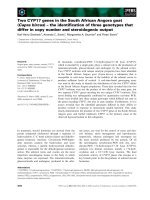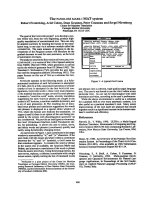Popular Attitudes Towards the South African Electoral System docx
Bạn đang xem bản rút gọn của tài liệu. Xem và tải ngay bản đầy đủ của tài liệu tại đây (234.76 KB, 56 trang )
Popular Attitudes Towards the South African
Electoral System
Report to the Electoral Task Team
By Roger Southall and Robert Mattes
HSRC
Publishers
Free download from www.hsrc
p
ress.ac.za
Democracy and Governance Research Programme, Occasional Paper 1
Series Editor: Prof Roger Southall, Executive Director: Democracy and Governance Research
Programme, Human Sciences Research Council
Published by the Human Sciences Research Council Publishers
Private Bag X9182, Cape Town, 8000, South Africa
© 2002 Human Sciences Research Council
First published 2002
All rights reserved. No part of this book may be reprinted or reproduced or used in any form or
by any electronic, mechanical, or other means, including photocopying and recording, or in any
information storage or retrieval system, without permission in writing from the publishers.
ISSN 1726-0175
Cover design by Jenny Young
Produced by comPress
Printed by Print24.com
Distributed in South Africa by Blue Weaver Marketing and Distribution, P.O. Box 30370, Tokai,
Cape Town, South Africa, 7966. Tel/Fax: (021) 701-7302, email:
Free download from www.hsrc
p
ress.ac.za
Preface
The Democracy and Governance programme of the Human
Sciences Research Council publishes an Occasional Paper series
which is designed to offer timely contributions to debates,
disseminate research findings and otherwise engage with the
broader research community. Authors invite comments and
responses from readers.
Free download from www.hsrc
p
ress.ac.za
About the Authors
Roger Southall is Executive Director, Democracy and Gover-
nance, Human Sciences Research Council. He was formerly
Professor of Political Studies at Rhodes University, and before
that worked at universities in Uganda, Lesotho, Canada and the
United Kingdom. He may be contacted at
Robert Mattes is Associate Professor of Political Studies and
Director of the Democracy in Africa Research Unit / Centre for
Social Science Research at the University of Cape Town. As an
Associate to the Institute for Democracy in South Africa, he is
also co-founder and co-Director of the Afrobarometer, a
regular cross national survey of Africans’ attitudes toward
democracy, economics and civil society. He may be contacted
at
Free download from www.hsrc
p
ress.ac.za
Popular Attitudes Towards the South African Electoral System
v
Executive Summary
At its simplest, any formal review of the type of electoral
system as in South Africa has three broad options. First of all,
it could conclude that things should be left as they are.
Second, it could conclude that radical reforms are necessary
and call for a shift to a fundamentally different system based
purely on constituency representation. Or third, it could call
for moderate reforms to address the weaknesses of a purely
proportional representation system by infusing it with
elements of constituency representation while guaranteeing
overall proportionality of legislative seats to votes.
To what extent can the views of ordinary South Africans
inform such a choice? Even to the most optimistic public
opinion researcher, the task of measuring citizens’ preferences
on this issue is daunting. True, those South Africans who have
voted in both national and local government elections now
have at least some exposure to different kinds of electoral
systems, to which middle-aged and older white citizens add the
memories of a purely constituent-based system. But the degree
to which people have internalised what happens once they
cast their vote, or its implications for the behaviour of elected
officials and party leaders, is certainly open to question.
Thus, in order to provide the Electoral Task Team (ETT)
with the most useful information on public attitudes, this sur-
vey of public opinion focuses first on measuring public views
of the system they have in front of them, and second, on
assessing what they want out of a voting system in general. To
the three broad choices outlined above, the responses reveal
the following conclusions:
Free download from www.hsrc
p
ress.ac.za
• There would be little public support for a radical shift
toward a ‘first-past-the-post’, single member constituency
system. This is good news for the ETT since the Constitu-
tion requires that any system result ‘in general, in propor-
tional representation’. In fact, South Africans appreciate
the achievements of the current system in maximising
many values that a ‘first-past-the-post’ system would have
difficulty providing, such as proportionality, but also
maximum inclusiveness and fairness. There is minimal
preference for the type of candidate-centred, United
States-style weak party system that a ‘first-past-the-post’
system can encourage. Indeed, for the most part, people
are happy with the present system.
• If South Africans are generally satisfied with what they
have, does this mean that the ETT should say simply ‘if it
ain’t broke, don’t fix it’? We feel the evidence provided by
the survey answers in the negative. First of all, public
satisfaction with the current system is neither consensual
nor widespread. Significantly higher proportions are
dissatisfied than one would prefer, given that a voting
system is an integral part of the overall constitutional
framework. Second, while South Africans appreciate that
the existing system produces proportionality, inclusiveness
and fairness, they also emphasise other values that a pure
list-based version of proportional representation has
difficulty producing: values such as independently-minded
legislators accountable to local grassroots public opinion.
• Finally, far from saying ‘it ain’t broke’, other survey results
suggest strongly that the system is broke in at least one
very important way. While Parliament has tried to address
the lack of a direct connection between the people and
the legislature by assigning putative constituencies to
Members of Parliament (MPs), very few South Africans
contact their MPs, and evidence from other surveys
demonstrates that few people can even hazard a guess
about who their MP is. Perhaps most damning, this
survey shows that just one in five South Africans think
Roger Southall and Robert Mattes
vi
Free download from www.hsrc
p
ress.ac.za
that national and provincial legislators listen to the opi-
nions of ordinary citizens or look out for their interests.
Left unchecked, such views threaten to turn into a cancer
in the body politic that slowly eats away at public
confidence in democratic institutions.
The introduction of a constituency system would not,
in itself, resolve all the issues giving rise to voters’ percep-
tions that South Africa’s politicians are not adequately
responsive to their needs. However, the introduction of
some form of constituency system would provide for a
direct link between voters and their representatives,
thereby enhancing the sense of obligation of the latter to
the former. This survey seems to suggest that voters
would favour the introduction of a Mixed Member
Proportional (MMP) system, featuring the introduction of
multi-member constituencies. Such a reformed system
would maintain overall representivity (as well as other
favoured electoral values), whilst simultaneously enhanc-
ing prospects for accountability.
Popular Attitudes Towards the South African Electoral System
vii
Free download from www.hsrc
p
ress.ac.za
Free download from www.hsrc
p
ress.ac.za
Popular Attitudes Towards the South African
Electoral System
Report to the Electoral Task Team
The Electoral Task Team (ETT), chaired by Dr Frederick Van
Zyl Slabbert, was established by Dr Mangosuthu Buthelezi,
Minister of Home Affairs, in May 2002. Its purpose was to
review the current electoral system and recommend any
reforms in time for the next general election. Any such reforms
have to be implemented in terms of Section 4 (1) of the 1996
Constitution (Act No. 108 of 1996), which states that the Natio-
nal Assembly shall consist of no fewer than 350 and no more
than 400 members elected through an electoral system that:
• is prescribed by national legislation;
• is based on the national common voters’ roll;
•provides for a minimum voting age of 18 years; and
•results, in general, in proportional representation (PR).
Section 4 (2) adds that an Act of Parliament must provide a
formula for determining the number of members of the
National Assembly. Similar provisions – Sections 105 (1) and
(2) – apply to the composition and election of the provincial
legislatures.
To inform their thinking, the ETT commissioned a nationally
representative survey of public attitudes about the qualities of
the current electoral system, and how it might be improved
1
Free download from www.hsrc
p
ress.ac.za
within the constraints of the Constitution. It was conducted by
four prominent South African research survey companies
(ACNielsen, MarkData, Markinor, and Research Surveys) and co-
ordinated and analysed by the Human Sciences Research
Council (HSRC).
Framework and methodology of the survey
The specific objectives of the survey were to obtain informa-
tion from amongst the pool of potentially qualified voters
concerning levels of political awareness and participation,
knowledge of the political system, sources of information on
politics and government, previous and potential voting
behavior, attitudes toward the current electoral system and pre-
ferred values to be achieved by an electoral system. A
recommended questionnaire was designed for the ETT by
the HSRC, containing both structured and semi-structured
questions. The ETT made final decisions about which question
items were included in the final version.
1
The questionnaire was administered face to face to a
random, nationally representative sample of 2 760 South African
citizens of voting age, between the period 16 July and 16 August
2002. This included 60 pilot interviews to test the length of the
interview and the formulation of the questions.
The HSRC designed the sample of the target population,
with the sampling population defined as all people living in
households and hostels (but excluding special institutions
such as prisons and hospitals) who could be contacted and
interviewed. A list of all Enumerator Areas (EAs) based on the
1996 census was used as a sampling frame. The list contained
descriptive data on the number of people and number of
households for each EA in the country.
The final sample was a random, disproportionate, multi-
stage, stratified, cluster sample. The list of EAs was stratified
into nine provincial lists, and then into four population groups
within each province, and further into rural and urban lists. To
obtain the required sample of 2760 individuals, 690 EAs were
Roger Southall and Robert Mattes
2
Free download from www.hsrc
p
ress.ac.za
randomly selected from these lists with the probability of
selection proportionate to population size. Finally, an implicit
stratification by home language was introduced through a
method known as ‘controlled selection’.
Within each of the selected EAs, four visiting points were
randomly selected. At each visiting point, all eligible respon-
dents were enumerated and one respondent was randomly
selected. No substitutions were allowed. If the selected
respondent was not at home at the time of the first visit
(normally made after working hours), two follow-up visits
were made at agreed times and dates. Questionnaires were
administered in the language of the interviewees’ choice, with
appropriate use of show cards. Interviewers reported that the
questionnaire was formulated clearly and was user-friendly.
This resulted in a sample that was representative because it
was random and because each South African had an equal and
known chance of being interviewed. However, some excep-
tions were necessary to enhance the reliability of the analysis.
In the Northern Cape and amongst the three minority popula-
tion groups (white, coloured and Indian respondents), strictly
proportional selection would have resulted in insufficient
numbers of respondents selected to support detailed analysis.
Thus, a disproportionate number of EAs was selected among
these strata. These cases, however, were subsequently
weighted downward so that they would have the proper
influence on the final national results.
Attitudes toward the current electoral system
South Africa’s first two democratic, non-racial general elections
(including elections for the nine provincial assemblies), held
in 1994 and 1999, were conducted under a national list system
of PR, with no minimum fixed proportion of the total number
of votes or threshold required for parties to gain representa-
tion in Parliament or provincial assemblies. The choice of this
electoral system was an outcome of the negotiation process
that produced the democratic settlement, and was dictated by
Popular attitudes towards the South African electoral system
3
Free download from www.hsrc
p
ress.ac.za
the perceived characteristics of this form of PR. Notably, it had
the virtues of, first, being simple to use and to explain to
voters. Second, it provided for maximum representation
thereby ensuring the inclusion rather than the exclusion of
minority parties and opinions. Third, because it was inclusive,
it was more likely than alternative electoral systems to
encourage reconciliation and co-operation between the
competing political parties (a quality that was enhanced in the
first Parliament by a constitutional requirement requiring a
government of national unity consisting of all parties winning
a minimum number of seats). Overall, the idea of propor-
tionality was seen as vital to allay suspicions that the electoral
system would unfairly favour one party over another (as can
notoriously happen via the manipulation of the demarcation of
constituency boundaries under the plurality systems used in
South Africa prior to 1994, or still in use in the US, UK and
most Commonwealth countries).
2
If the mechanics of the national list PR system were inten-
ded to provide a system that was ‘fair’, then the political
assumption on which that intention was based was that
elections held under its rubric would also be ‘free’. In the post-
negotiation South African context, this required that parties
would encounter ‘a level playing field’ in the sense that no
party would be favoured above others by the governmental or
administrative machinery. To this end the 1994 and 1999
elections were run by the Independent Electoral Commission
(IEC), established under the 1994 Constitution and charged
with administering elections in a politically neutral way.
Fairness and equality Given these imperatives driving the
selection of the present electoral system, we begin by repor-
ting results to a set of question items that gauge public opinion
about these very aspects of the current system. Because peo-
ple may have very different levels of knowledge about the
existing system, the interviewer began this set of questions by
informing respondents that:
Roger Southall and Robert Mattes
4
Free download from www.hsrc
p
ress.ac.za
General elections are normally held every five years. In these elec-
tions, people vote for a political party. The top people from each
party’s list of candidates then go into Parliament or the provincial
assembly according to how many votes each party receives. Once
Parliament is elected, the Members of Parliament elect the
President and the members of provincial legislatures elect the
Premiers.
The survey then asked respondents a series of questions
about their opinions of the current electoral system. Looking
across these questions, it is clear that a substantial majority feels
that, overall, the present system is fair and treats parties and
voters equally.
3
Three-quarters say they are ‘satisfied’ with ‘the
way we elect our government’ (74 per cent) and agree the sys-
tem is ‘fair to all parties’ (72 per cent). Approximately two-thirds
feel that ‘all voters were treated equally’ in the 1999 election
(68 per cent) and that ‘all parties were treated equally’ in 1999
(63 per cent). Thus, the voters agree with scholars who focus
on PR’s ability to represent broad swathes of plural societies.
4
Popular attitudes towards the South African electoral system
5
Table 1.The fairness and equality of the present electoral system
Are you satisfied with the way we elect our
government in South Africa?
Is the voting system fair to all parties?
Do you think that all voters were treated equally
in the 1999 general election?
Do you think all parties were treated equally in
the 1999 general election?
Neutral/
don’t know
Ye s No
74 5 21
72 11 17
68 14 18
63 16 21
Before we proceed further, we need to step back and think
about the criteria we use to evaluate these and subsequent
responses. The typical analysis of public opinion looks care-
fully at issues of the balance of opinion, that is, at which
options are supported by a plurality or even a majority of
Free download from www.hsrc
p
ress.ac.za
respondents. However, readers need to consider whether
normal majority/plurality/minority considerations are adequate
criteria to judge these results. Should support for the funda-
mentals of the constitutional system (such as national identity,
democracy, the Constitution itself, and the way we elect our
representatives) enjoy a scope of legitimacy broader than a
simple majority? Do electoral systems require what political
scientist David Easton once called ‘diffuse support’, meaning a
type of support for government that is almost consensual and
cuts across all societal cleavages?
5
With these considerations in mind, these results taken
together suggest that the system is far from ‘broke’ in the eyes of
voters. Accordingly, caution ought to be exercised in ‘mending
it’. However, against that, we note that fully one-fifth of respon-
dents are dissatisfied with the present system, and that around
one-third are either dissatisfied or non-committal in their judge-
ment. In other words, support for the current system is less than
consensual and significantly-sized minorities are dissatisfied.
Accountability There is a similar pattern of responses to a
series of questions on the breadth of representation and
degree of political accountability produced by the present
system (Table 2).
6
Four-fifths of respondents feel that the
system ‘ensures that we include many voices in Parliament’ (81
per cent) and that the system gives voters a chance to ‘change
the party in power’ (78 per cent). Around seven in ten say the
system enables voters to ‘influence Parliament’ (71 per cent),
that it produces ‘the best possible government’ (69 per cent),
and that it allows voters to hold political parties ‘accountable
for their actions’ (68 per cent). However, we see a notable drop
off in agreement when we ask whether the system helps
voters ‘hold individual representatives of government
accountable for their actions’: here, just 60 per cent agree and
fully one-quarter (25 per cent) disagree.
All of this suggests that voters recognise that the system
produces a high level of representativeness and also believe
Roger Southall and Robert Mattes
6
Free download from www.hsrc
p
ress.ac.za
that it allows them to turn the party in power out of office, if
necessary. In other words, while several commentators have
categorised the African National Congress (ANC), which won
63 per cent and 67 per cent of the national vote in 1994 and
1999 respectively, as a ‘dominant’ party,
7
voters do not neces-
sarily view its position as unassailable. In other words, most
voters believe that the electoral system enables them to make
their voices heard in the halls of Parliament and ensures that
political parties ‘anticipate’ their reactions at the next election
to the actions they take today.
8
However, these results also suggest that many voters agree
with those political scientists who argue that PR’s weakest area
is that it does not allow the electorate to hold individual par-
liamentarians and government officials accountable.
9
This is
particularly notable in the context of the task that the ETT has
been given. It must take into account the widespread argu-
ment that the national list PR system weakens the political
accountability of individual members of legislatures by
empowering party leaderships (who exert considerable
Popular attitudes towards the South African electoral system
7
Table 2: The electoral system and political accountability
Does the voting system ensure that we include
many voices in Parliament?
Does the voting system give voters a way to
change the party in power?
Can voters influence Parliament?
Does the voting system give us the best possible
government?
Does the voting system help voters hold the
parties accountable for their actions?
Does the voting system help voters hold
individual representatives of government
accountable for their actions?
Neutral/
don’t know
Ye s No
81 8 11
78 9 14
71 11 18
69 9 22
68 12 20
60 15 25
Free download from www.hsrc
p
ress.ac.za
influence in the construction of the parties’ lists of candidates
for election). In contrast, constituency or geographic
representation provides a more direct link between voters and
their representatives, whilst simultaneously demanding of the
latter a dual loyalty (to both their party and their constituents).
We will address this question at greater length below. On the
whole, however, the results in Tables 1 and 2 display a
relatively high level of satisfaction with the existing system.
Explaining popular evaluations of the electoral system In
order to test which factors structure attitudes towards the
current electoral system, the survey measured a range of basic
demographic characteristics (eg. age, race, home language,
education, household type, employment, province and rural-
urban status). It also measured a series of attitudinal and
behavioural factors such as respondents’ main source of poli-
tical information, their political knowledge, political interest,
and their political participation in previous elections and other
forms of political activity.
Statistical analysis revealed that, as in so many other areas
of public opinion in South Africa, the most important demo-
graphic structuring characteristic is race. For instance, if we
revisit the issue of satisfaction with the present electoral
system, we find that white, coloured and Indian respondents
are considerably less satisfied than black voters with various
aspects of the current system. At the same time, readers should
note that the overlap is far from complete.
10
Between one-third
and one-half of white voters, and just above one-half to 60 per
cent of coloured and Indian respondents, offer positive assess-
ments of the current system. It is also notable that between 12
and 15 per cent of black respondents register dissatisfaction
with the system. Clearly, many other factors besides race shape
the way voters think about the political world.
What may be most significant for the ETT is the fact that
there is greatest cross-racial agreement with the items that
refer to the electoral system per se (i.e. ‘the way we elect our
government’, ‘the voting system is fair’) than with the items
Roger Southall and Robert Mattes
8
Free download from www.hsrc
p
ress.ac.za
that refer more to election administration (‘treatment’ of parties
and voters). Thus, although the overall objectives of the present
electoral system would seem to earn relative approval across
all racial groups, the mode of its implementation appears to be
in considerably greater dispute. Again, however, we refer
readers to the issue of how much support is required for
something such as an electoral system, and how widespread
that support should be.
Popular attitudes towards the South African electoral system
9
Table 3: Fairness and equality of the present electoral system (by race)
Satisfied with way we elect our
Government.
Voting system is fair.
Voters were treated equally in 1999
general elections.
Parties were treated equally in 1999
general elections.
Percentage agree
Indian
Black
White
Coloured
81 51 56 64
78 48 55 68
75 37 55 57
70 34 46 52
There are smaller racial differences in attitudes toward the
degree of political accountability produced by the current
system.
11
There is broad cross-racial agreement that the system
allows people to influence Parliament and produces as broad-
ly representative a Parliament as possible. However, whites in
particular are considerably less optimistic than other voters
that the system enables people to hold individual representa-
tives and political parties accountable or that it produces the
best government possible. Readers should note that the fairly
widespread misgivings of the minority voters that the electoral
system renders parties and individual politicians unaccount-
able is also shared by over a fifth of blacks. As will be
illustrated in Table 4, these queries about accountability are
Free download from www.hsrc
p
ress.ac.za
We use regression analysis to examine the factors that
shape how people view the electoral system, testing all rele-
vant demographic, attitudinal, and behavioural factors
measured in the survey.
12
Tables 5 and 6 display the most important standardised
regression coefficients (all results are displayed in Appendices
A and B). These coefficients take into account that the
different factors are measured with different scales and
summarise the relative impact of each factor on views of the
electoral system. We see that race still plays a very strong role.
Even when we statistically control for the impact of differences
in rural-urban status and educational status, white, coloured
and Indian respondents are still considerably more negative in
their assessments of the equality and fairness of the system
than are blacks. Controlling for other factors, whites are signi-
ficantly less positive about the political accountability of the
Roger Southall and Robert Mattes
10
Table 4: Political accountability of the electoral system (by race)
The voting system ensures we include
many voices in Parliament.
The voting system offers a way to
change the party in power.
The voting system gives us the best
possible government.
The voting system holds parties
accountable.
Voters can influence parliament.
The voting system holds
representatives of government
accountable.
Percentage agree
Indian
Black
White Coloured
83 70 77 82
81 53 73 80
77 37 55 59
73 43 61 66
72 64 70 85
64 38 57 64
echoed in people’s thinking about the relative values of alter-
native electoral systems.
Free download from www.hsrc
p
ress.ac.za
system than all other voters. Moreover, these differences
remain even when we control for differences in respondents’
approval ratings of elected officials. This strongly suggests that
racial differences in evaluations of the electoral system are not
simply a function of their disapproval of the party in govern-
ment, the ANC. With regard to the other important demo-
graphic determinants, more educated respondents are more
likely to say that the system produces fair and equal results,
and those who live in formal housing are less likely to say that
it produces accountability. Other demographic factors such as
rural-urban distinctions and gender had no impact.
At the same time, readers should note that job approval
ratings of elected officials themselves have a major impact on
how people see the electoral system (they are the second
strongest determinant after race of popular views of the
system’s equality and fairness, and have the single strongest
impact on assessments of its accountability). In other words,
controlling for all other factors, the more people approve of
the way their elected leaders do their jobs, the more positive
they are about the electoral system. Since we know from other
research that job approval ratings are heavily shaped by parti-
san factors, we interpret this to mean that views of the
electoral system are also strongly shaped by partisan criteria
(independently of the impact of race). To support this inter-
pretation, we also point to the fact that those respondents who
identify with a political party are much more positive about
both aspects of the current electoral system than other voters.
Based on the results of virtually all other research on this
matter, we know that the large majority of these identifiers
support the governing party, the ANC.
13
Since the impact of
partisanship remains even after we have statistically controlled
for the impact of race, this means that the 57 per cent of black
respondents who identified with a party (predominantly the
ANC) are far more likely to approve of the existing system
than the 43 per cent who are politically ‘independent’. That
South Africans view the current electoral system through a thick
partisan lens is something that the ETT needs to take seriously.
Popular attitudes towards the South African electoral system
11
Free download from www.hsrc
p
ress.ac.za
Finally, those respondents who are interested in politics
have more positive assessments of both aspects of the current
system than those who are not. Interaction with the political
system (in the sense of making contact with elected officials,
and party or community leaders) leads to more positive assess-
ments of the system’s freeness and fairness, and those who
have voted most often since 1994 are more likely to feel that
the system produces accountability.
Roger Southall and Robert Mattes
12
Table 5: Determinants of evaluations of the equality and fairness
of the system
Demographics
White
Coloured
Indian
Education
Political attitudes
Approves of overall performance of elected leaders
Interested in politics
Identifies with a political party
Political behaviors
Voting participation since 1994
Makes contact with leaders
Adjusted R
2
Standardized
coefficients (Beta)
42**
15***
09***
.05*
.27***
.08***
.06**
.09***
.05*
.38
Dependent variable: index of perceived equality and fairness of current
electoral system.
Table displays all variables with a Beta weight equal or greater than .05.
** In this and subsequent tables, one asterisk indicates significance at the level
of .05, two asterisks at the level of .01 and three asterisks at the level of .001.
Free download from www.hsrc
p
ress.ac.za
Popular attitudes towards the South African electoral system
13
Table 6: Determinants of evaluations of the accountability of the
electoral system
Political attitudes
Approves of overall job performance of elected officials
Identifies with a political party
Interested in politics
Demographic factors
White
Lives in area with formal housing
Political behaviours
Voting participation since 1994
Adjusted R
2
Standardized
coefficients (Beta)
.27***
.11***
.09***
25***
07**
.08***
.28
Dependent variable: index of perceived accountability of current electoral system.
Table displays all variables with a Beta weight of .05.
What do South Africans want out of an electoral
system?
The broadly positive popular views of the current voting sys-
tem mean that there is little pressure for a radical move to a
fundamentally different type of system. But can we conclude
that the voters see no need for any reform? Recall that we
have already seen that political support for the existing system
is far from consensual. Significant pockets of negative and pes-
simistic opinions exist, located disproportionately (though clear-
ly not wholly) amongst racial minorities. But negative opinion
is also concentrated amongst the sizable proportions of black
respondents who are dissatisfied with the performance of elec-
ted officials, who do not identify with a political party, and
who are less engaged with the political process (cognitively or
behaviourally).
Moreover, when we ask voters about the sorts of things that
they want a voting system to produce, large proportions and
Free download from www.hsrc
p
ress.ac.za
even majorities emphasise features that South Africa’s model
of pure proportional representation has great difficulty
producing. These things, in order of preference, are a direct
connection between local areas and legislators, greater
grassroots control over legislators, a directly elected President,
greater freedom for legislators to criticise their own political
parties and take their own stances on legislation indepen-
dently of the party line, and the potential for independent
candidates. At the same time, when posed the choice, most
respondents want a Parliament that is as broadly repre-
sentative as possible, even at the risk of slowing the legislative
process. They also want parties to nominate more women,
and indeed favour requiring them to do so. This section will
review these results in detail.
The ETT and the survey designers were conscious from the
start that levels of public knowledge about competing electoral
systems were likely to be scant at best. Thus, the survey took
an alternative route and attempted to get at the kinds of broad
values that people felt should be maximised in an ideal voting
system. Two types of questions were used to get at these
preferences. First of all, respondents were asked an open-ended
question to tap what voting meant to them. Second,
respondents were given a range of paired statements intended
to get them to express preferences on prominent dimensions of
electoral choice often identified by analysts of electoral systems.
The meaning of voting We turn first to the question of what
voting means to South Africans. The responses reveal at least
three important lessons (see Table 7). First of all, South
Africans exhibit a high degree of literacy on the subject. Just six
per cent are unable to articulate any meaning to voting. This
echoes the high turnout rates in the first two democratic
general elections.
14
It could reflect at least two different factors.
First, the goal of ‘one man, one vote’ was the overarching theme
of the entire liberation movement. Second, international donors,
local and international Non-Government Organisations (NGOs)
and the South African IEC have poured large amounts of
Roger Southall and Robert Mattes
14
Free download from www.hsrc
p
ress.ac.za
resources and efforts into voter education since 1993. The evi-
dence seems to support the second option. In testimony to the
broad-based reach of voter education, educated respondents
are no more likely to offer some understanding of voting than
less educated respondents.
15
The most important demographic
difference appears to be age: older voters are significantly more
likely to say they ‘don’t know’ when asked what voting means.
16
Second, there is little sign of cynicism about the act of
voting. Just four per cent gave comments that could be
described as indifferent or negative views toward voting. Most
of these people told interviewers that voting made no
difference. But the important point is that this opinion is held
at the moment by an extremely small percentage of eligible
voters. Thus, whatever the differences among South Africans
about the efficacy of the present electoral system, there is
widespread agreement that the act of voting – universally
acknowledged as perhaps the key characteristic of democracy
– is important.
Third, voters infuse voting with a variety of meanings, many
of which can apparently be held simultaneously. Three specific
cognitions of voting were mentioned most frequently. It is
important to remember that respondents were allowed to offer
more than one response. Their responses were written down
verbatim and coded into broader categories after the fact. The
most frequently mentioned meaning was to see voting in
procedural terms, as a way to select representatives and govern-
ment officials or leaders (mentioned by 42 per cent of all
respondents). Mentioned just as frequently, and often by the
same people who offered a procedural understanding, 42 per
cent of all respondents attribute a substantive or instrumental
purpose to voting (that is, they see it as a tool for securing mate-
rial improvement in living conditions), many of whom para-
phrase the ANC campaign slogan and say that voting brings ‘a
better life’. Third, one-quarter (26 per cent of all respondents)
say voting has an important symbolic purpose: that is, to vote is
an act of participating in a democracy and an expression of
citizenship and responsibility to society.
17
Finally, some 10 per
Popular attitudes towards the South African electoral system
15
Free download from www.hsrc
p
ress.ac.za
Roger Southall and Robert Mattes
16
Table 7: The meaning of voting
Voting is about electing representatives 42
Voting is about electing persons, leaders, the President. 16
Voting is about electing someone who will consider our needs 13
and rights.
Voting is about choosing the right person or party. 8
Voting is about electing a government. 5
Voting allows transmission of needs and demands 41
Voting is about getting the things we want or need. 6
Voting is about getting help to obtain pensions, electricity, 9
water and housing.
Voting is about getting help to get employment. 8
Voting is about securing a better life. 13
Voting is about transformation and improving life in the 5
community.
Voting symbolizes citizenship 26
To vote is to vote for our country. 1
Voting is about being involved in society, being involved in 2
South Africa; it is about taking part.
Voting is about making a difference, contributing to society. 2
Voting is about being heard. 8
Voting is about getting equality / equal treatment for everybody. 3
Voting is about exercising our democratic rights, fighting for 9
our needs.
Voting is about being recognised as a citizen. 1
Voting allows identification with charisma 10
Voting enables you to choose a person or party you admire. 10
Other 45
Voting does not make a difference 4
It makes no difference if you vote or not, voting is a 3
waste of time.
Other indifference comments. 1
Don’t know 66
Can you describe what it means to you to vote?
Percent
Free download from www.hsrc
p
ress.ac.za
cent see voting as an act of identification with a party or person
they admire, a figure which is surprisingly low given that 52 per
cent of respondents claimed that they felt close to a political
party. This may suggest that South Africans’ partisan identifi-
cation is potentially more fluid than is often assumed.
With a few exceptions, responses show few important vari-
ations according to race. White (37 per cent), coloured (40 per
cent) and Indian respondents (37 per cent) are more likely to
see democracy in symbolic terms than are black respondents
(21 per cent). Coloured respondents are far less likely to see
democracy in procedural terms (22 per cent) than all others.
White respondents are far less likely to see democracy in sub-
stantive terms (14 per cent) than all others.
While the overwhelming majority of South Africans attach
major significance to voting and signal their intent to participate
in the next general election, this does not necessarily mean that
they all want the same outcomes from an electoral system. In
order to tap the things people want a voting system to do, we
offered respondents a range of paired statements. As mentioned
previously, the goal was to get people to express preferences on
prominent dimensions of electoral system choice that have been
identified by analysts of electoral systems. We can group
responses to these questions into four major dimensions. First of
all, a set of questions measured people’s positions on the relative
importance of individual candidates versus political parties.
Second, a set of items examined where South Africans stand on
the issue of localised versus centralised control of political parties.
Third, a set of questions assessed where respondents place
themselves on the issue of individual autonomy versus internal
party discipline. A fourth set of questions measured people’s
preferences on the issue of representation versus legislative
efficiency. Finally, one question item asked people about their
preferences for direct election of the President. We will detail the
precise way in which each of these issues or dimensions is
connected to the choice of electoral systems.
Popular attitudes towards the South African electoral system
17
Free download from www.hsrc
p
ress.ac.za









